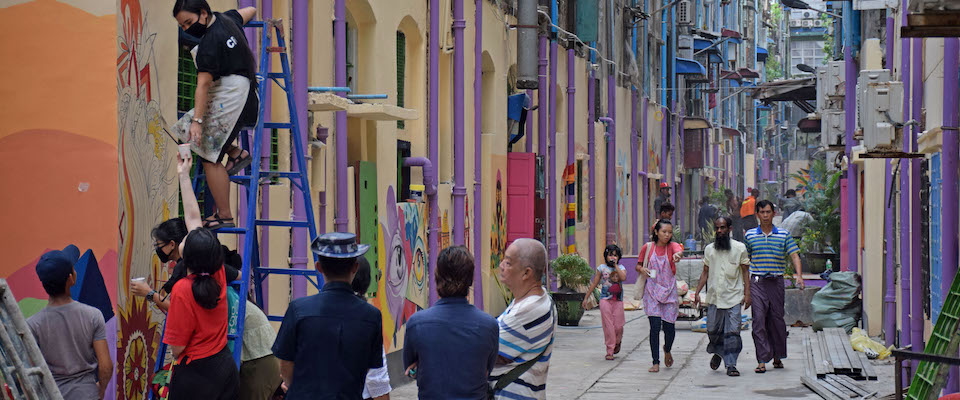After the nonprofit workers cleaned out all the garbage from behind his building, Win Nit, a native of Yangon, Myanmar, was amazed at how much space was back there.
“I didn’t even consider this spot as anything but a dump,” he says, frying samosas in an alley that was once buried under a thigh-high drift of trash.

Now the plastic bags, broken bottles and rats’ nests have given way to benches, flower boxes and a swingset in one of the latest projects by Doh Eain (Burmese for “our home”), a social enterprise founded by UC Berkeley alumna Emilie Röell that is transforming the filthiest corners of Yangon into parks, playgrounds, street art galleries and concert venues.
“What we’re hoping to do with our projects and awareness activities is to help people realize that these buildings, these spaces, they are a valuable asset that can’t be bought.”
When Röell moved to Yangon as an advisor for the United Nations Development Programme in 2013, she found the colonial-era architecture rotting under layers of refuse and decay, with more developers opting to demolish the old buildings than to restore them.
“I started working on an idea to do a garden in a back alley, and that got much bigger,” Röell says. After her first, unofficial alleyway garden project went viral on social media, Röell put together a team of urban planners, designers, artists, and community leaders, and Doh Eain was born.
Each new project by Doh Eain is planned by a committee of local residents who decide what the space will contain—be it a playground, a wall for aspiring street artists, or a market area to sell fresh vegetables. “We work with communities that want to protect and reimagine their heritage and public spaces,” Röell says.

Since its official launch in 2017, Doh Eain has enjoyed an outpouring of government support and corporate sponsorships for its signature urban oases, several of which have become popular stops for city tour companies.
But for the organization, success is about more than public recognition.
Designer Swan Yee Tun Lwin, who goes by Swan, returned to her native Yangon after completing a degree in Landscape Architecture at Berkeley. She explains that the larger mission of Doh Eain isn’t merely to beautify Yangon, but to change the way its residents think about their city, to show younger generations that the crumbling, trash-strewn cityscape is something to be preserved rather than bulldozed.
“Placemaking in general is still a concept that is new to Yangon.”
“What we’re hoping to do with our projects and awareness activities is to help people realize that these buildings, these spaces, they are a valuable asset that can’t be bought,” says Swan. “Once you destroy it, it’s gone.”
Swan, who grew up in Yangon under a military regime with no interest in open public spaces where people might gather remembers “not having a lot of public spaces as a kid. We would usually just play out on the street.”
Yangon wasn’t always that way. The oldest attendees of Doh Eain’s focus groups remember a time after independence and before Myanmar’s 1962 coup that would leave Myanmar politically and economically isolated for 50 years. Back then, the country was a model of post-colonial development. “These spaces, before they became trash alleys, were used as backyards,” Swan says.
But changing the way Yangonites view their own city isn’t easy.

“Placemaking in general is still a concept that is new to Yangon,” says Swan. “It’s a somewhat Western way of approaching design, and a lot of the basic systems needed to apply it haven’t been developed here…When we can do it right, it is very satisfying.”
Swan describes a recent effort to prepare Yangon’s historic Bogalay Zay Street for the first annual Singapore Festival, a weekend street fair organized by the Singapore Tourism Board. Doh Eain brought together residents, business owners, and local administrators to wash and repaint the neglected colonial buildings, decorate blank walls with murals, and line the sidewalks with trees and flower gardens.
The event itself was a success, but Swan says the praise she cherishes most doesn’t come from newspaper reporters, city officials or even young locals like Win Nit. It comes from the very oldest residents of Yangon, people who remember before the military regime, before the city fell into disrepair—when people mingled in parks and squares and alleys were places to play, wash clothes, or catch up with neighbors.
“We have spoken with old people who tell us, ‘I remember when I was a kid, I used to play here, I used to sit here and spend time in this space,’” Swan says. “It’s good to see that again.”




















